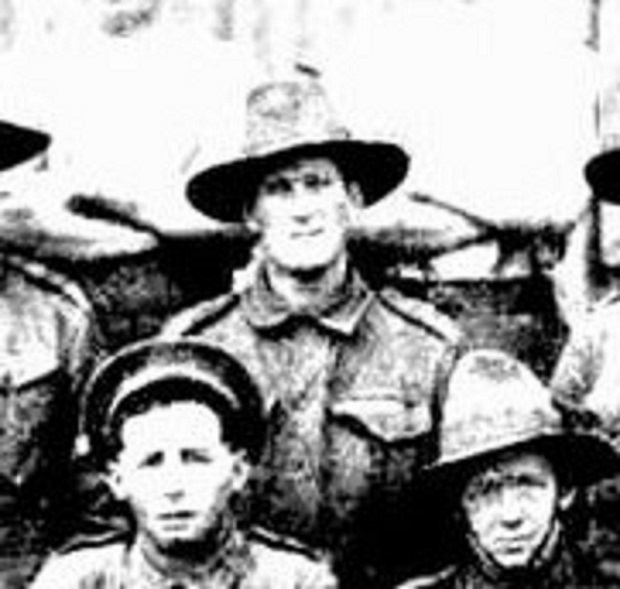
34th BATTALION AIF
Corporal: 845 Robert Hamden MURRAY
Born: January 1896. Swansea via Newcastle, New South Wales, Australia. Birth Cert:7717/1896.
Died: 19th July 1917. Killed in Action. Wellington Trench, Messines, Belgium.
Father: Robert Murray. (1876-1916)
Mother: Mary Murray. nee: Sharp. (1974-1903) Died at West Maitland Hospital.
INFORMATION
Robert Hamden Murray enlisted with the AIF at Newcastle on the 4th February 1916 and was marched in to the Rutherford Army Camp at West Maitland where he was allocated to C Company 34th Battalion AIF. On the following morning, 2nd May 1916 the men embarked on the transport HMAT A20 "HORORATA" and sailed at 4:00 pm".
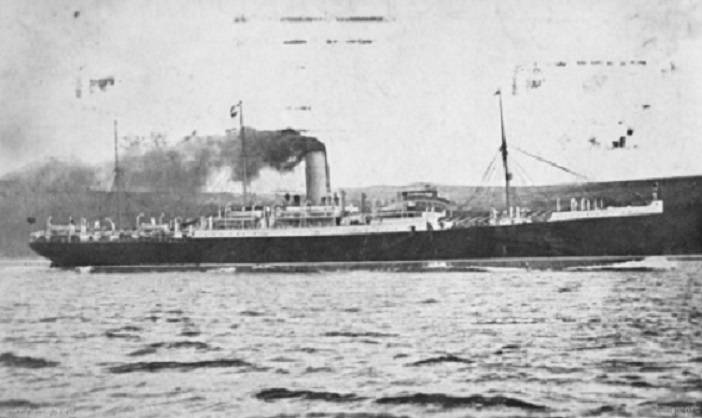
H.M.A.T. A20 "HORORATA
"The voyage to England was without any unusual incidents and a good passage throughout. The first port of call was Albany, where three days were spent. Columbo was reached on Empire Day, 24th May. Here two days were taken up coaling and taking on provisions, etc. During the stay the Battalion carried out a route march through the town. Suez was reached on 8th June, where a party of Light Horse and some details were disembarked. Arriving at Port Said on 9th, the ship coaled and proceeded to Alexandria which was reached on 11th June 1916.
Whilst at Alexandria, Robert was admitted to the 21st General Hospital at Alexandria suffering from Measles and was transferred to Tel-el-Tin on the 27th of June before he was discharged to duty on the 30th June 1916. Robert embarked from Alexandria on board the Hospital Ship "Megantic" on the 6th August and disembarked at Plymouth and en trained during the afternoon for Amesbury, arriving at midnight and marching to hutments at No: 1 Camp, Salisbury Plains at Larkhill.
Here Robert settled down to hard training, which included Route Marching, Trench Digging, Bomb Practice, Musketry and General Camp Routine. Later the Battalion moved to the No: 25 Camp and finished off their training, which included six days' battle practice and field work at the Bastard Trenches.
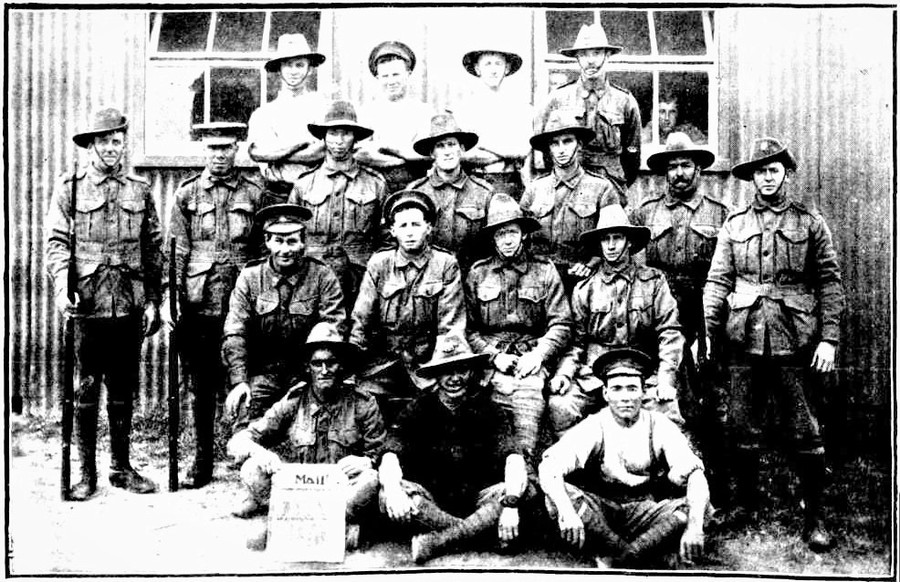
Some of the Original Wallabies – Salisbury Plain, England 1916. Section of C Company – 34th Infantry Battalion AIF.
Back Row: Private: 847 Lyle MURRAY; - Private: 903 Frank Dixon THOMAS; - Private: 774 Albert GREENFIELD; - Private: 828 James Muir LECKIE.
Third Row (standing): Private: 902 Christopher THOMAS; - Private: 875 Patrick PORTER; - Private: 751 Lial Edgar EDWARDS; - Private: 845 Robert MURRAY;
Private: 806 William Adolphus JOHNSTON; - Private: 716 Edward Mark BLATCHFORD; - Private: 730 Herbert Robert Duncan CHERRY.
Second Row (seated): Private: 756 Fred ENGLAND; - Private: 920 George Alexander WOODS; - Private: 769 James GRAHAM; - Private: 797 Charles William INGRAM.
Front Row: Private: 838 William David MORGAN; - Corporal: 713 John BELL; - Private: 793 Victor HUDDLESTON.
On the 9th October 1916, Robert was Charged with disobedience of Orders. Award 7 Days Pay Forfeited by C.O. On the 16th October, Robert was again Charged with disobedience of Orders. "In that he was deficient in Kit when on Pack Drill". Award 3 Days Confined to Barracks. by Captain: John Ambrose McDOWELL.
The 34th Battalion left Lark hill on the 21st November and en trained at Amesbury for Southampton, embarking on the S.S "Arundel". The transport section left by S.S. "Princess Victoria". The Battalion arrived at Le Harve, France on the 22nd November 1916. Disembarkation commenced at 8:00 am and the Battalion marched to No;1 camp on the Hill, arriving at 2:00 pm. The men carried heavy loads, in some cases amounting to miniature Q.M.' Stores. The march over cobblestones was very tiring, notwithstanding the many route marches which had been carried out at Larkhill. However, after bathing their feet and receiving treatment, as well partaking of a good meal, some spent a comfortable night.
On the 1st January 1917, Robert was treated by the 11th Australian Field Ambulance for Scabies and was removed from the lines and evacuated to the Convalescent Depot for further treatment and recovery. Robert returned to his unit after being discharged on the 21st January as the Battalion was advancing to the Houplines Sector.
On the 24th January 1917 the Specialists went into the Line in the Houplines Sector. The following day the 34th Battalion took over from the 36th Battalion, who's Commanding Officer: Lieutenant Colonel: James William Albert SIMPSON. had been killed the previous day. On the 29th January 1917 Major: Ernest Edward MARTIN. temporarily transferred to command the 36th Battalion until the 20th February when Lieutenant Colonel: John Alexander MILNE. became Commanding Officer. The Front Line here was very similar to last Sector. During this period a good deal of shelling was carried out on both sides enemy sending over "Pineapples" freely. Aerial activity increased and many fights took place. The Patrols were now gaining mastery of No Man's Land and Fritz was getting the "Wind up". Very Light displays, constant use of his Searchlights and bombing of his own wire were common occurrences during the night time.
7th June 1917.
THE BATTLE OF MESSINES
The 3rd Australian Divisions first major offensive was at Messines Ridge on the 7th June 1917. The Australian 3rd Division was a part of the II Anzac Corps which was allotted to the first assault. The 25th New Zealand, 3rd Australian Division with the 4th Australian Division in reserve. The 4th Division were battle hardened troops who had fought many major battles. The 3rd Australian Division were having problems getting to the "jump off" point. The day before the 9th and 10th Infantry Brigades were bombarded by German Gas-Shells around Hill 63 and Ploegsteert Wood. Many of the Aussies were not wearing gas masks, but despite this they pressed on even though they received 500 casualties.
They made it to the "jump off" point but only just with some of the men from the 9th and 10th going straight over the top without stopping. The mines went up and the attack commenced behind a protective barrage. The II Anzac Corps were attacking on the right with their objective being the southern shoulder of the ridge which included Messines, the Dover and St Yves areas as far south to the east of Ploegsteert Wood.
Major General Sir John MONASH's 3rd Division had to contend with a tricky 3 mile approach out of Ploegsteert Wood and after the German gas attack, but they were not deterred. The 9th Infantry Brigade under Brigadier General: Alexander JOBSON and the 10th Infantry Brigade under Brigadier General W R NICHOLL had just made the jumping off point but some of the men did not stop, going straight into the assault from the approach march.
Their objective lay between St Yves and the Douve. The mines at Trench 127 and Trench 12 at Factory Farm were laid to aid this task. The explosions erupted a few seconds before zero hour and created craters of 200 feet in diameter, completely obliterating the German defence line as the 9th and 10th Infantry Brigades went over the top. The mine crates forced the 9th and 10th Brigades to veer to the left and right which caused some confusion with the main assault. It is testimony to the quality of training that every man knew the ground, tasks and objectives so well.
Private: 1804 John CARROLL 33rd Battalion, rushed the enemy's trench and bayoneted four of the German occupants. He then noticed a comrade in difficulties and went to his assistance, killing another German. He then attacked single handed a German Machine Gun Team, killing all three of them and capturing the gun. He later rescued two of his comrades who had been buried alive by German Shell Fire, and in spite of heavy shelling and machine gun fire he dug them out alive and saved them from certain death. John was awarded the Victoria Cross.
The German forward zone was completely engulfed and taken by the main assault. The two supporting battalions of each brigade then passed the leading battalion to continue the advance. The men were constantly re-supplied and the ridge was taken. There were many German prisoners taken during the offensive. The 3rd Division was well ahead with the 9th Infantry Brigade pushing on beyond Grey Farm, and on the right the 10th Infantry Brigade were veering left towards Septieme Barn north of Douve.
The German resistance was heavy but was generally brushed aside by tanks and artillery before the infantry had to become too involved. The 4th Bavarian Divisions Artillery had made little impact, but as the day wore on the 3rd Division and later the 4th Australian Division received many casualties from German artillery. (70% of all casualties during WW1 were from artillery).
By 9:00am nearly 6 hours after the assault began the Germans were in disarray, but there was a major problem as the Australians received less casualties as anticipated and when ordered to dig into the ridge they had so many men, that some could not find shelter. the 35th battalion were dug in around Seaforth Farm.
The second phase of the operation was to take the Oosttaverne Line. The 3rd Australian Division would now be in reserve with the 4th Division attacking. The 9th Infantry Brigade (33-34-35-36Bn) were near Thatched Cottage facing Warneton. The river Lys was to their right and the Ploegsteert Wood was now behind them.
Once their objectives were taken the troops consolidated. A barrage to stop and counter attack was shortened and caught three battalions which had to retire. By 9:00 pm this part of the Oosttaverne Line was abandoned. At 10:45 pm General: Alexander John GODLEY ordered the 3rd and 4th Divisions to retake it. This they did by the early hours of the 8th of June.
The Battle for Messines Ridge during May-June 1917 saw 35 officers and 1,631 other ranks loose their lives.
9th Infantry Brigade Casualties.
| 33rd Battalion. AIF | 8 Officers | 382 Other ranks |
| 34th Battalion. AIF | 10 Officers | 378 Other ranks |
| 35th Battalion. AIF | 5 Officers | 431 Other ranks |
| 36th Battalion. AIF | 9 Officers | 421 Other ranks |
| 9th Machine Gun Company. AIF | 2 Officer | 17 Other ranks |
| 9th Light Trench Mortar Battery. | 1 Officer | 2 Other ranks |

FIELD DRESSING STATION, MESSINES 7th June 1917.
Robert was promoted to Temporary Corporal on the 20th June 1917 after the advance at Messines when Temporary Corporal: SULLIVAN was Killed in Action at Messines. He was buried in a Shell Hole a few yard north of Chapelle-de-Velours.
On the night of 3rd July the Battalion relieved the 33rd Battalion at Middle Farm. Lieutenant: Harold Wydham LILJA joined here with a number of reinforcements. The enemy was raining Shells on this position, but it was very noticeable that a large representation were "duds", as many 15 in succession. The Battalion was relieved by the 36th Battalion on 6th July, and on 7th July during the afternoon Lieutenant General: Sir Alexander John GODLEY held a review at Hillside Camp. Captain: Robert Joseph STEWART and Captain: Herbert Henry PERCY were decorated with the Military Cross, While 1 Distinguished Conduct Medal and 11 Military Medals were presented to Other Ranks.
19th July 1917.
Casualties 2 killed "Corporal: 845 Robert MURRAY - Private: 2097 John Henry JAMIESON" and 5 wounded Private: 198 Edward Abraham "Ted" SULLIVAN in WELLINGTON TRENCH. Enemy firing gas shells intermittently all night.
(34th Battalion War Diary)
Robert was Killed in Action at Wellington Trench at Messines, Belgium and is remembered with honour and is commemorated in perpetuity by the Commonwealth War Graves Commission at the Menin Gate War Memorial.

Menin Gate War Memorial
Family Information
Robert was a single 20 year old Labourer from Swansea, N.S.W. upon his enlistment with the AIF.
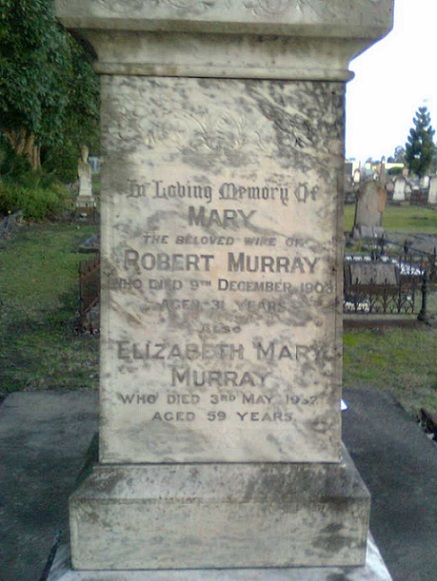
Murray family grave, Sandgate Cemetery. Alfred Ernest Murray Snr's - sister & sister-in-law Elizabeth and Robert's wife Mary.
Military Records


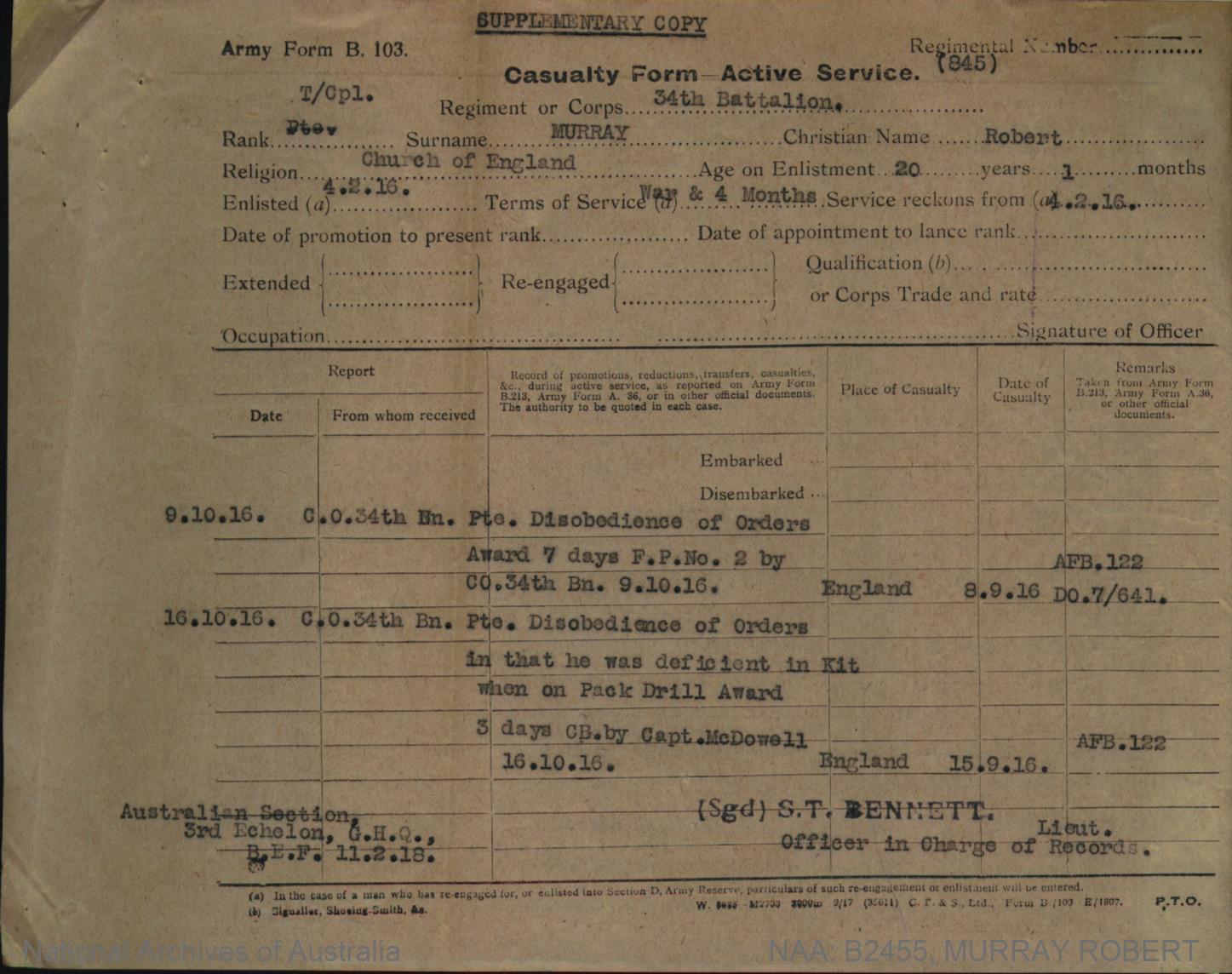
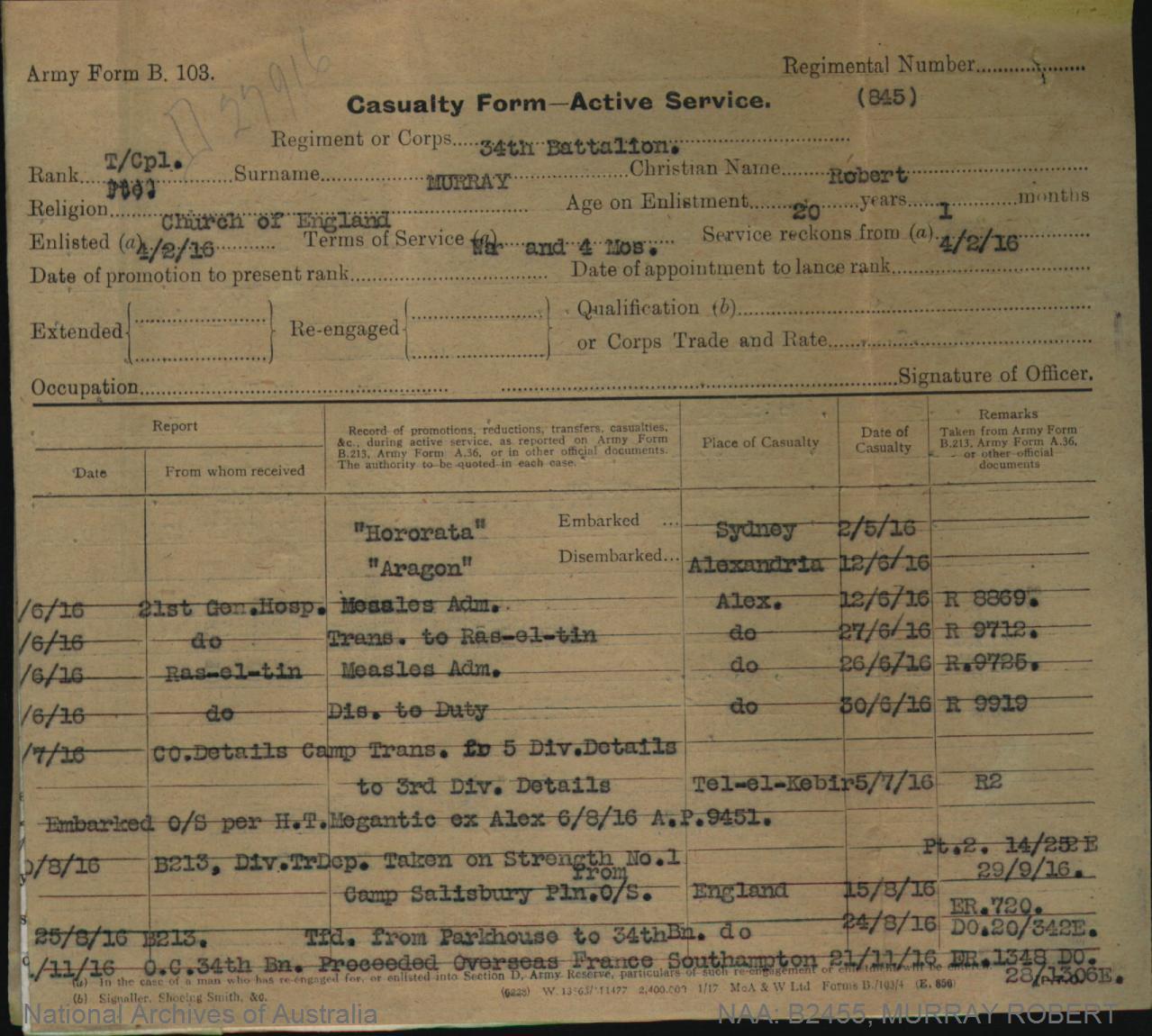


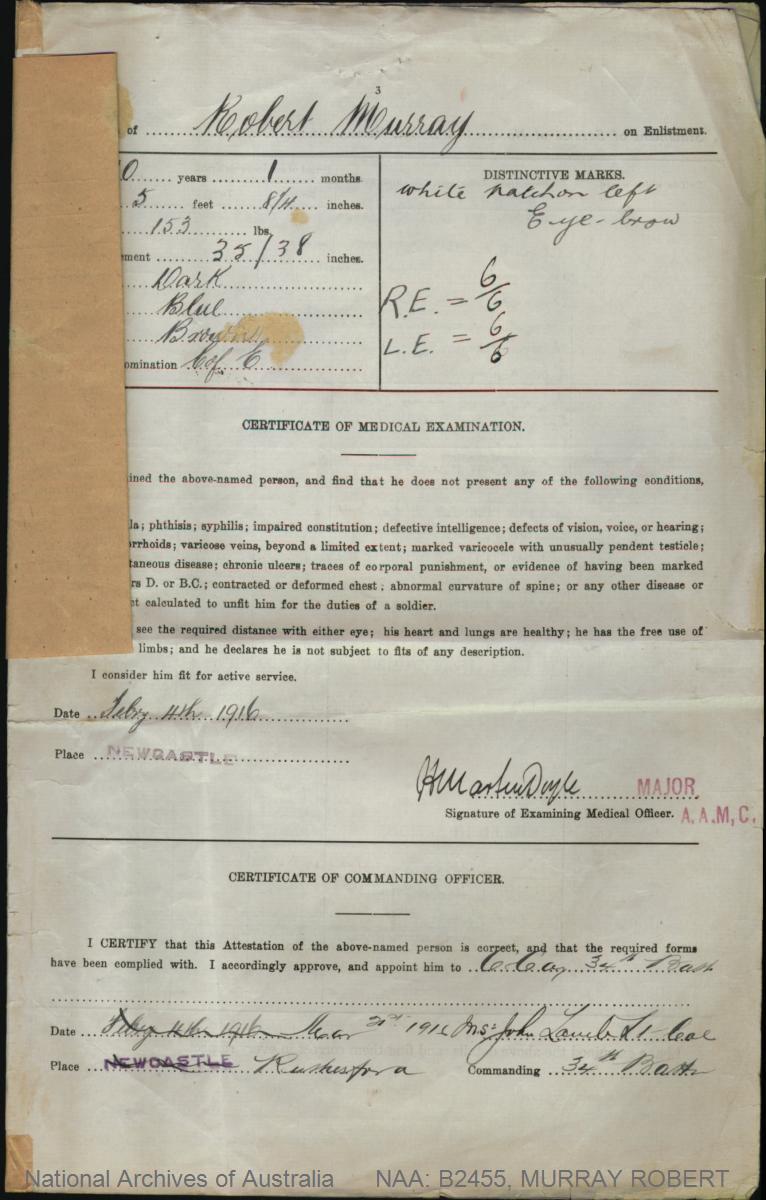


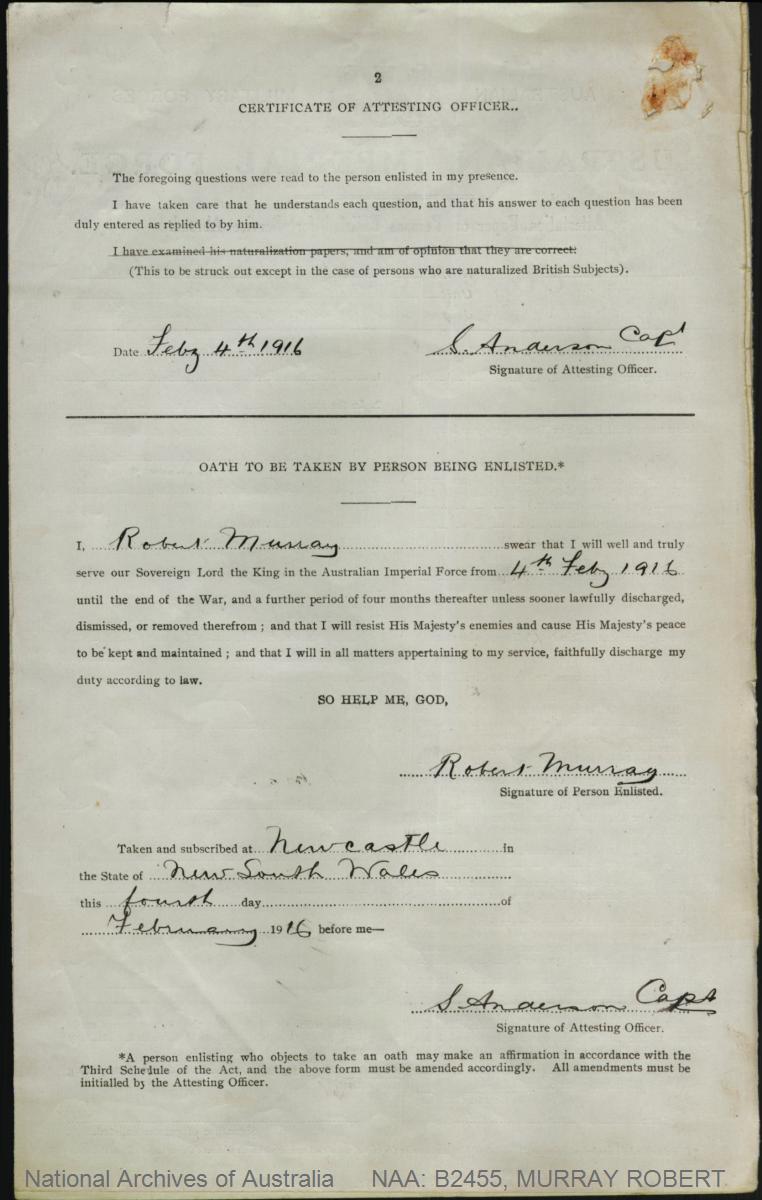
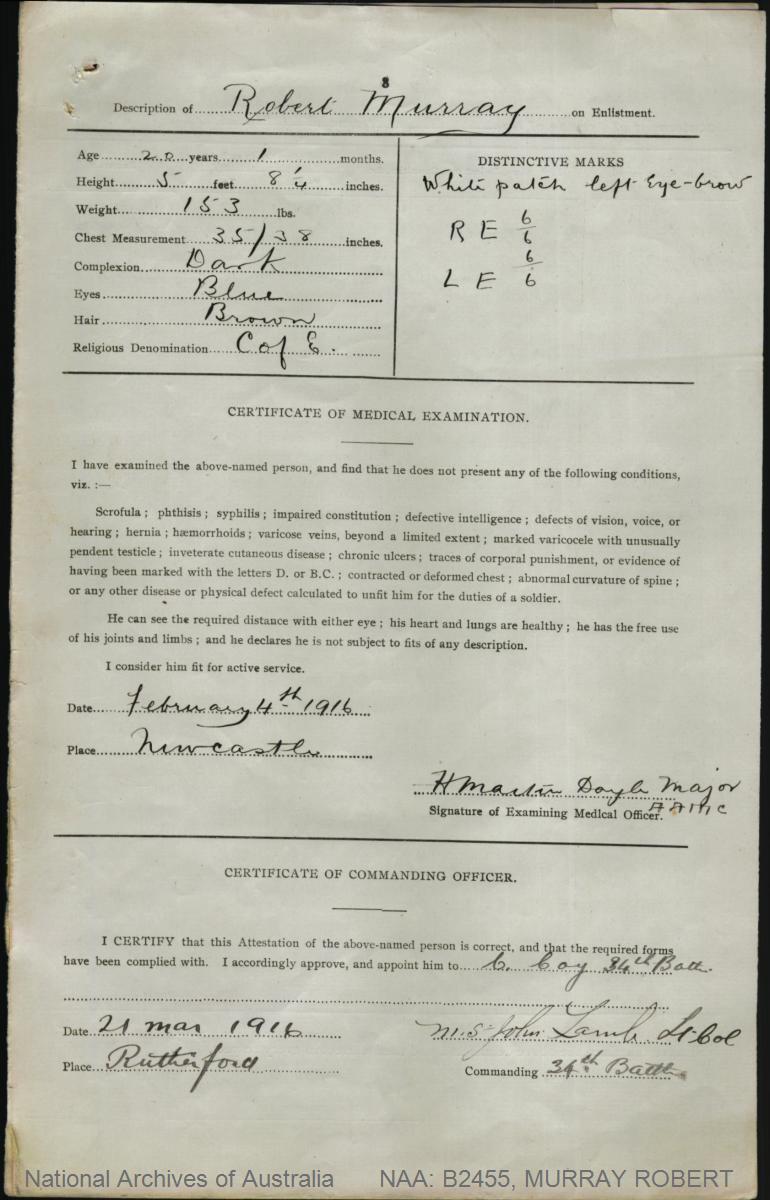
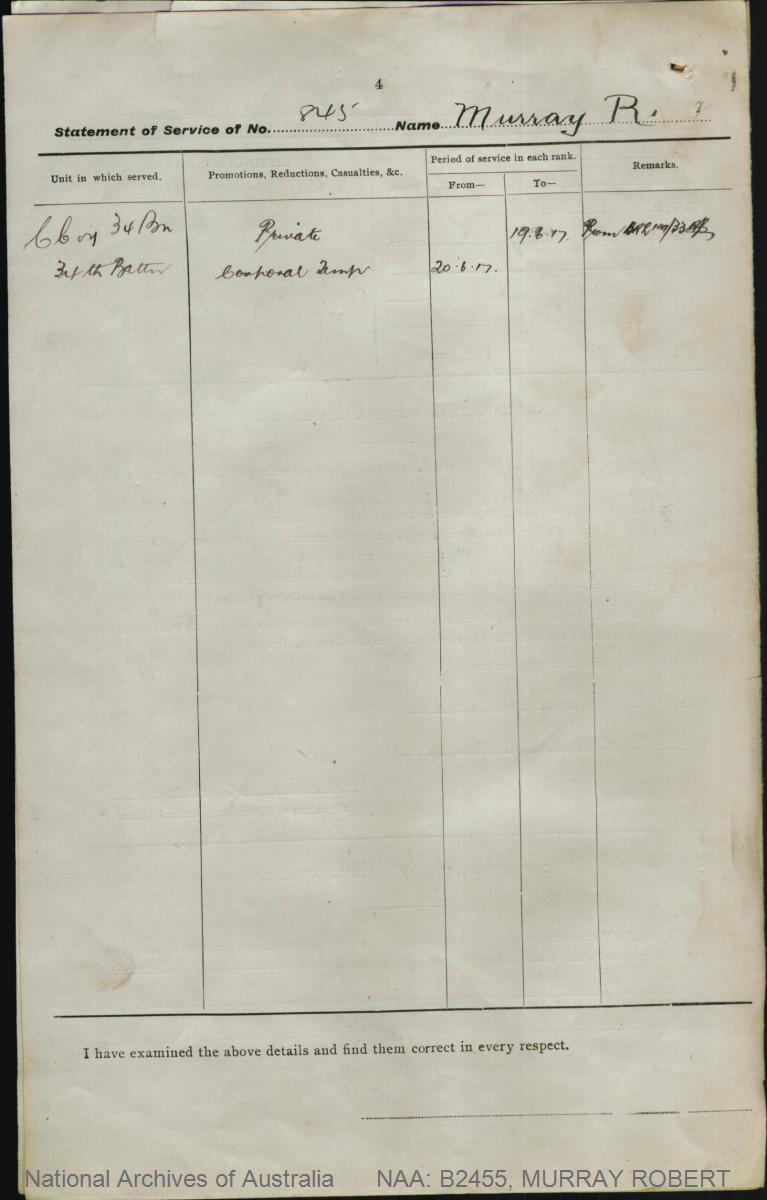
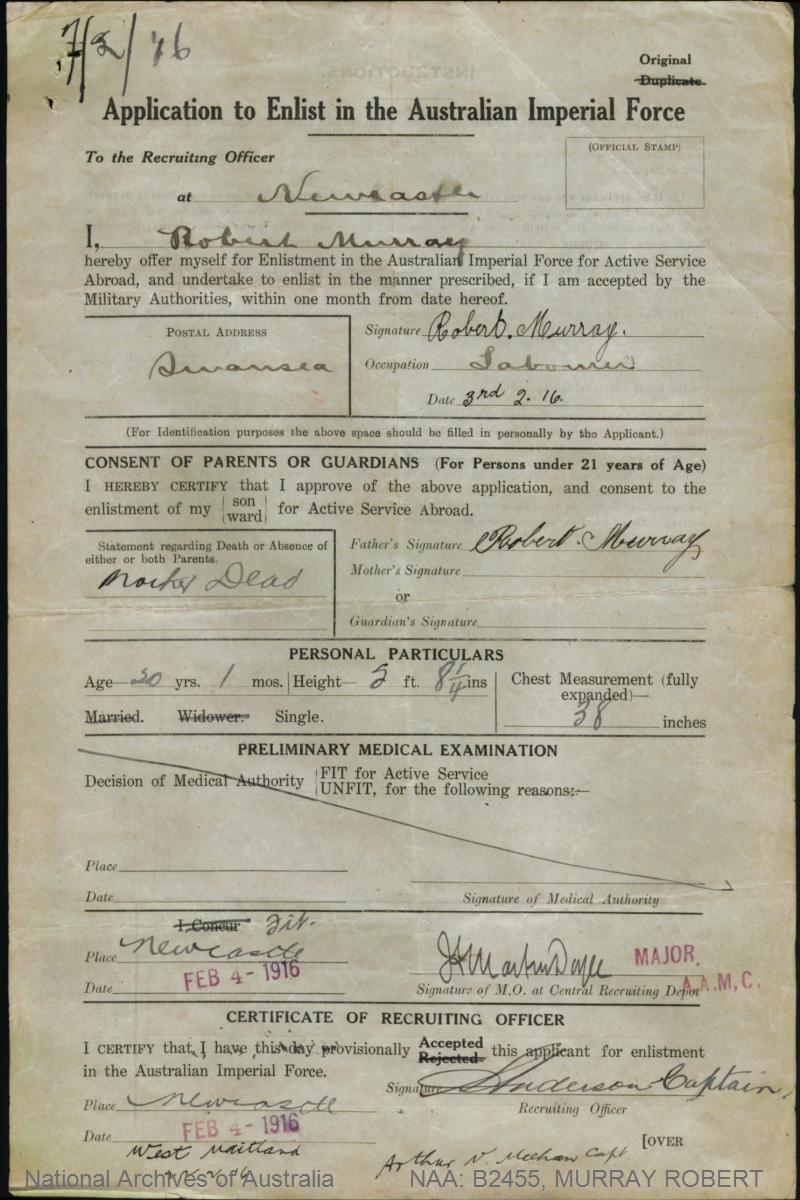
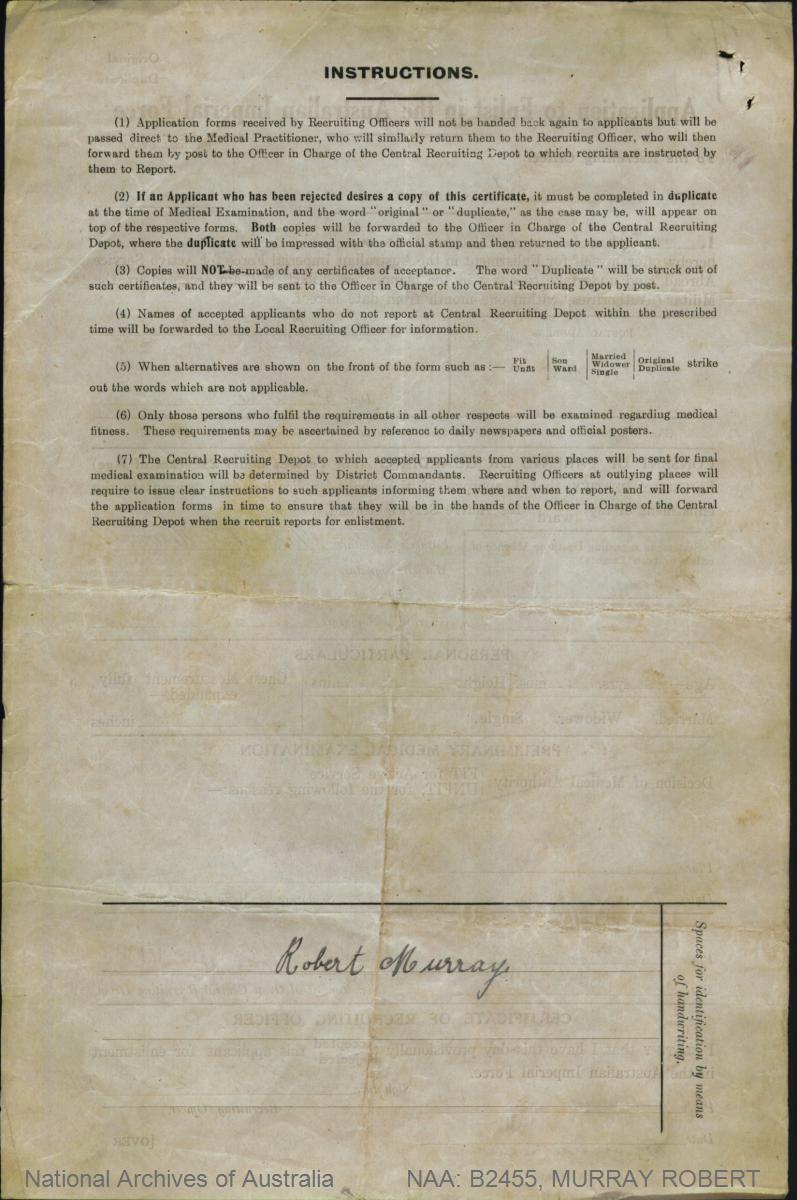
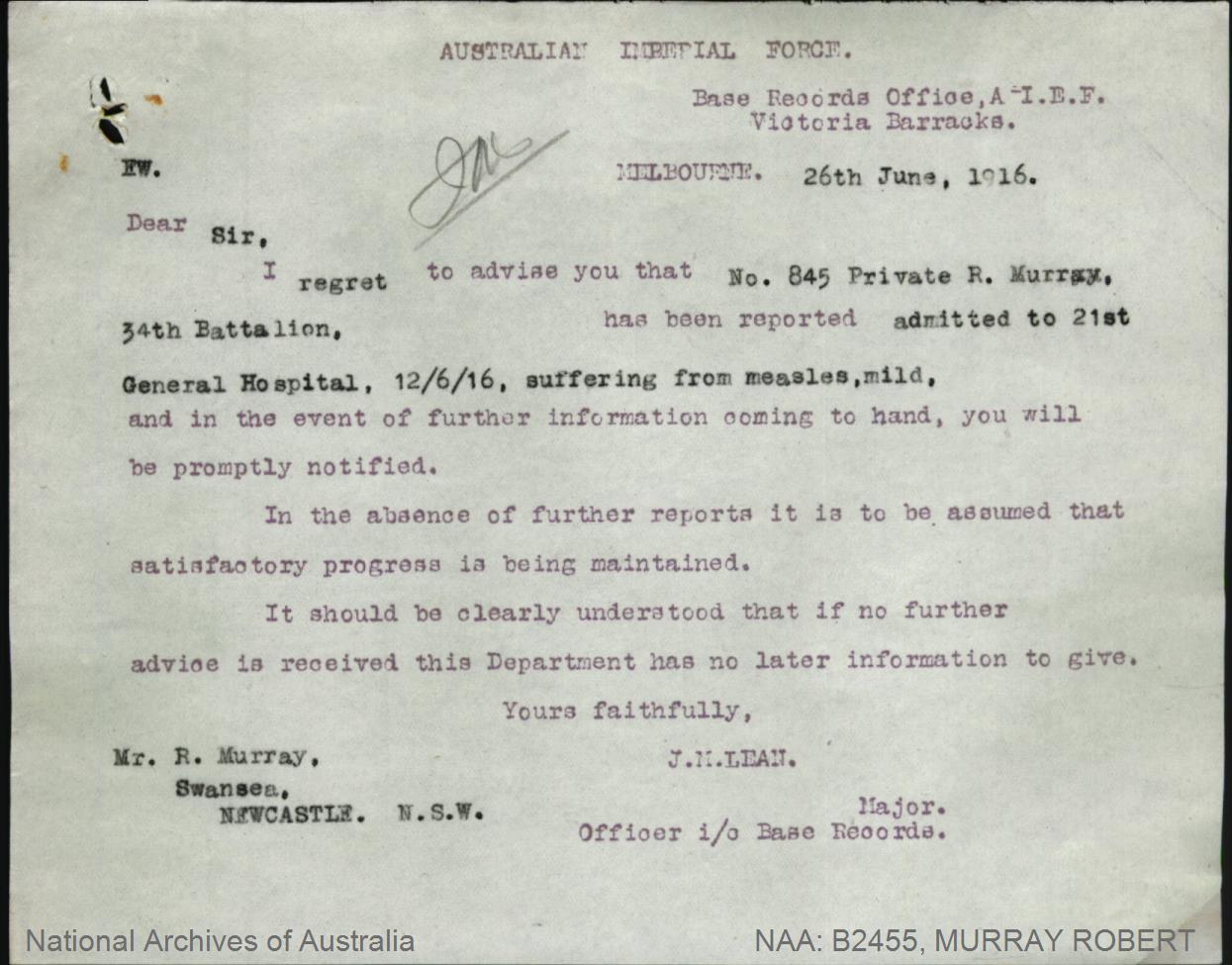
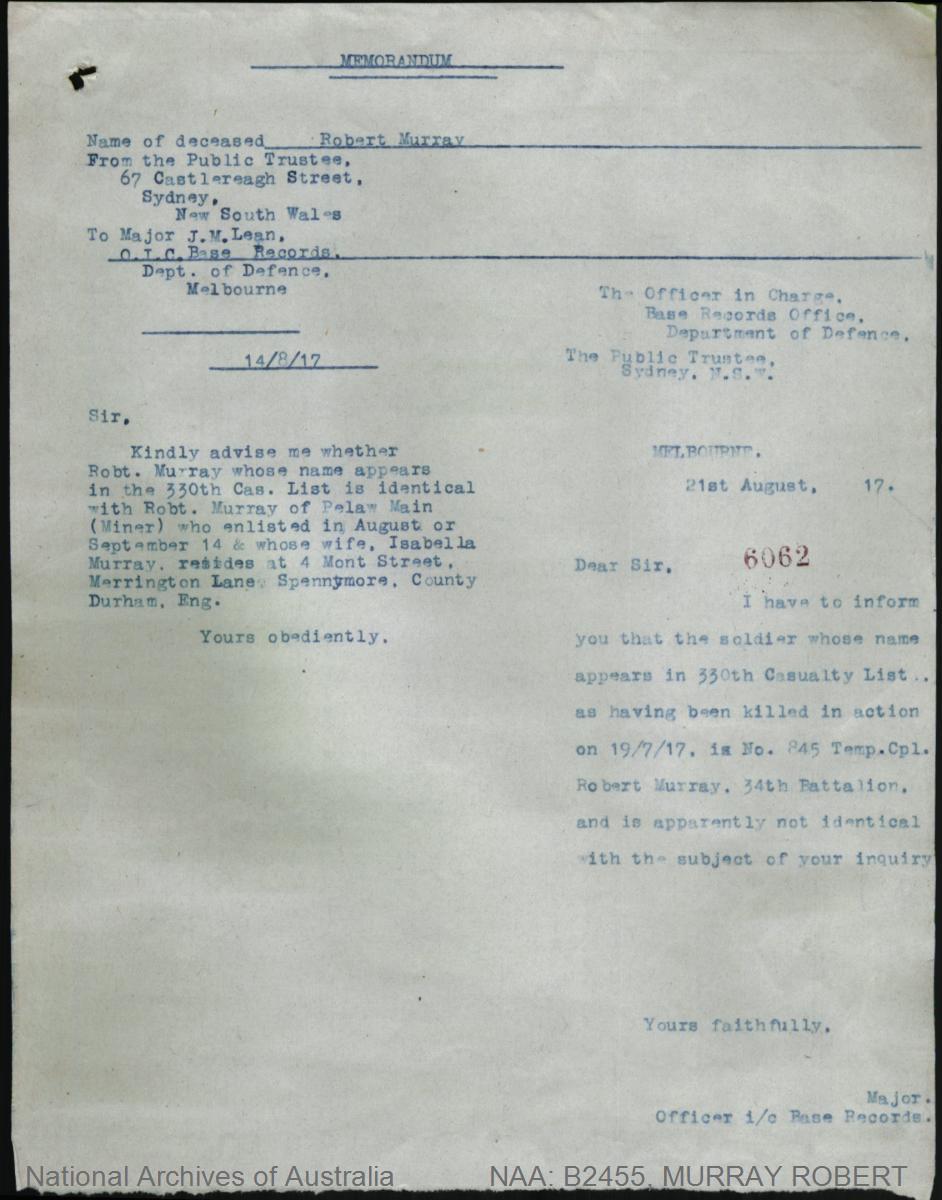
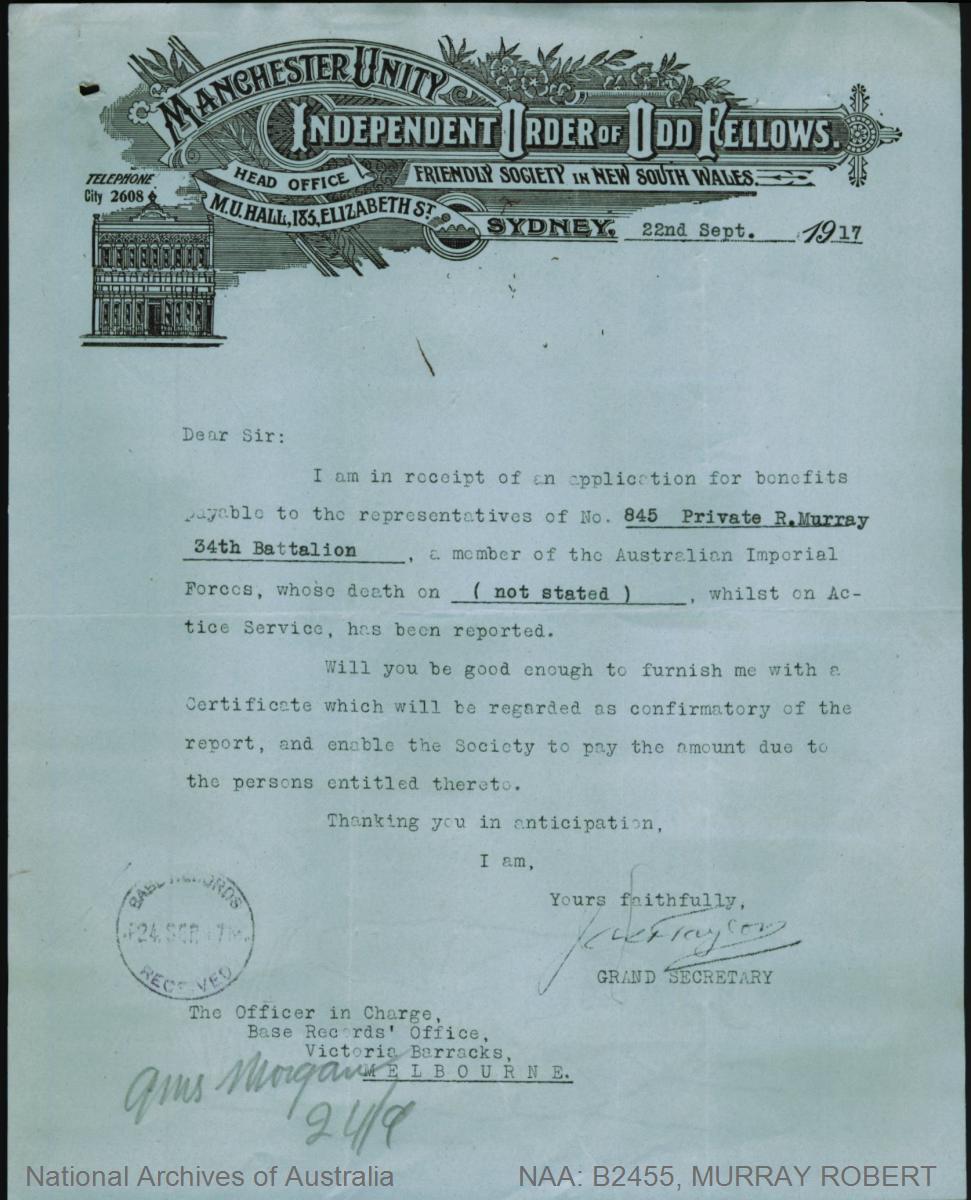
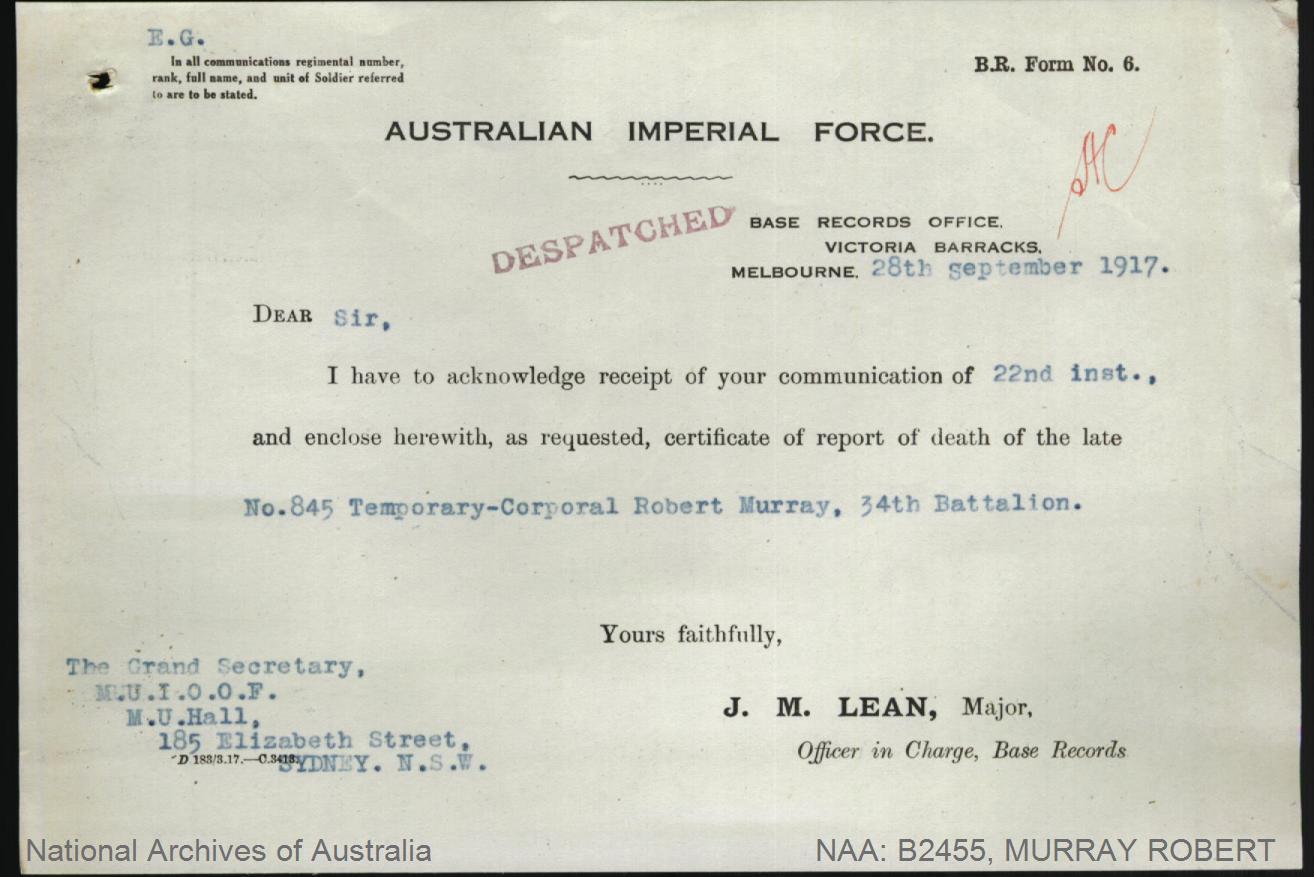
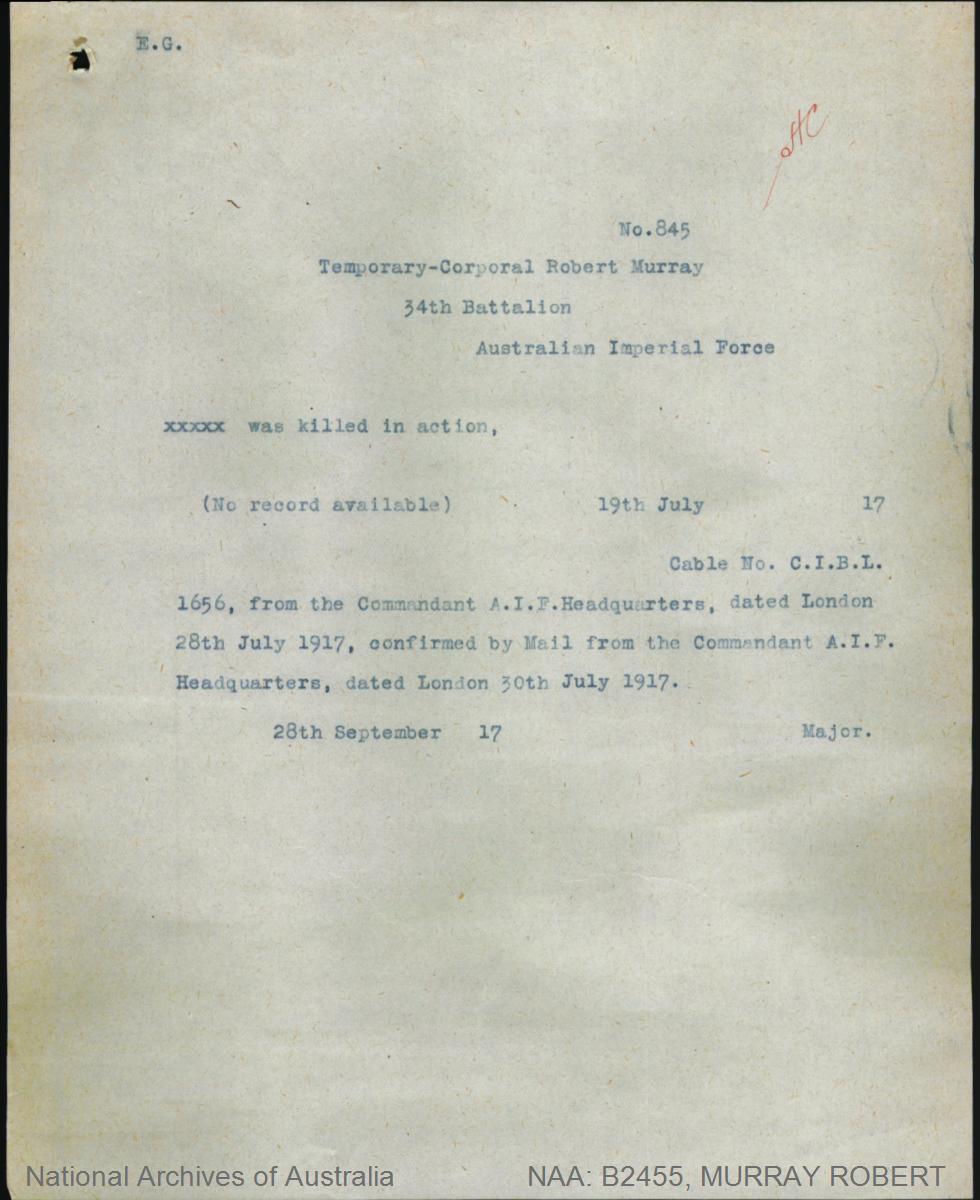
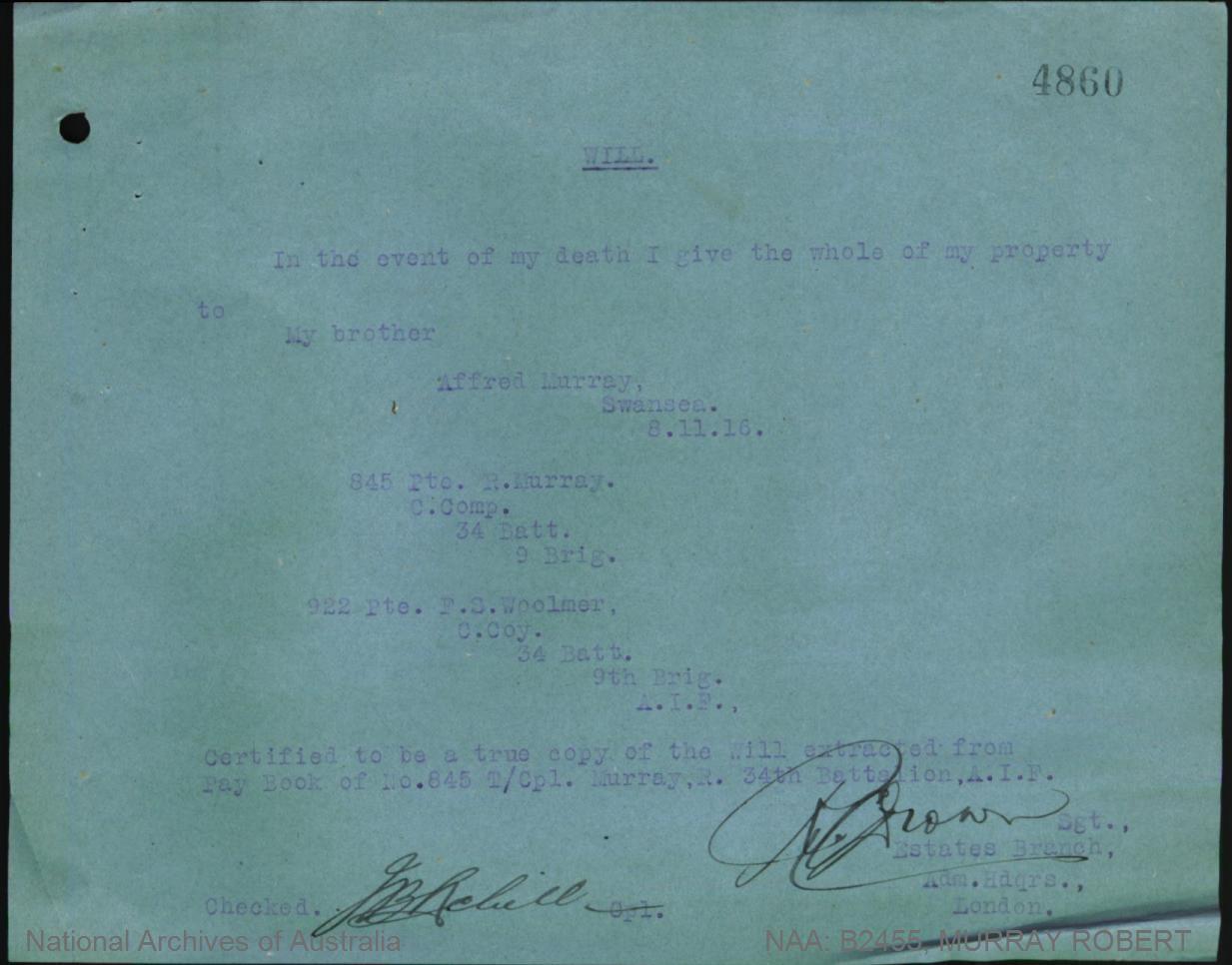
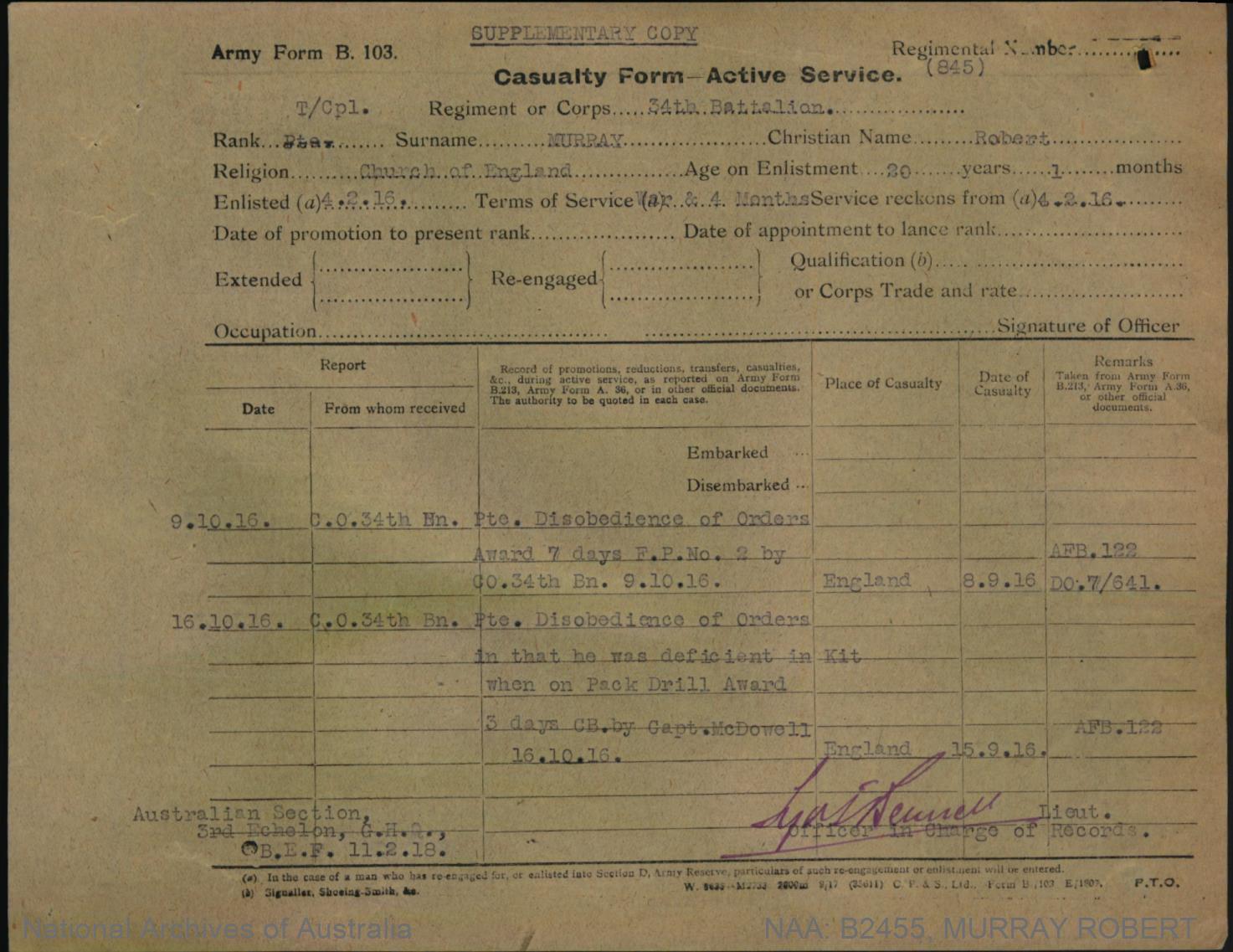

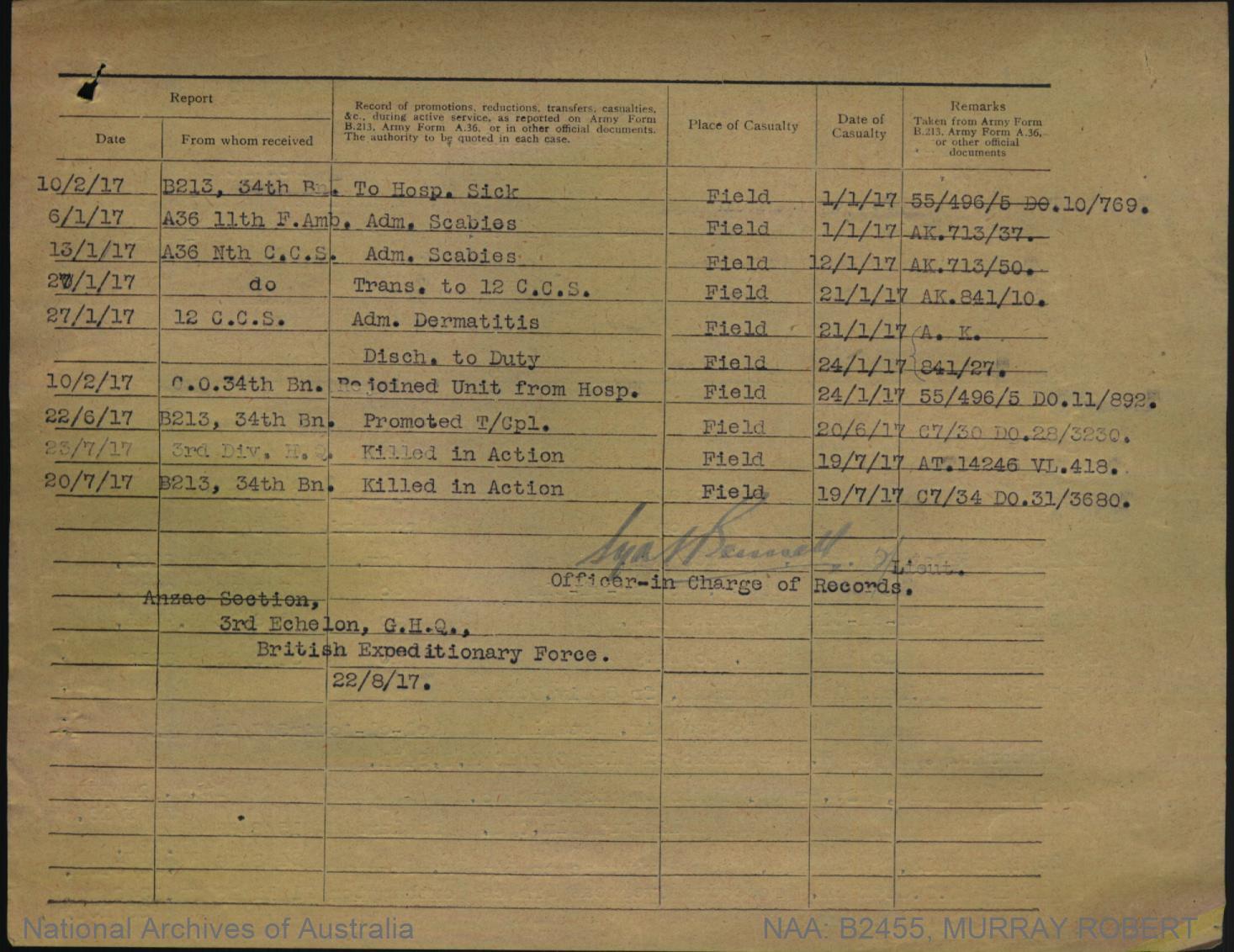
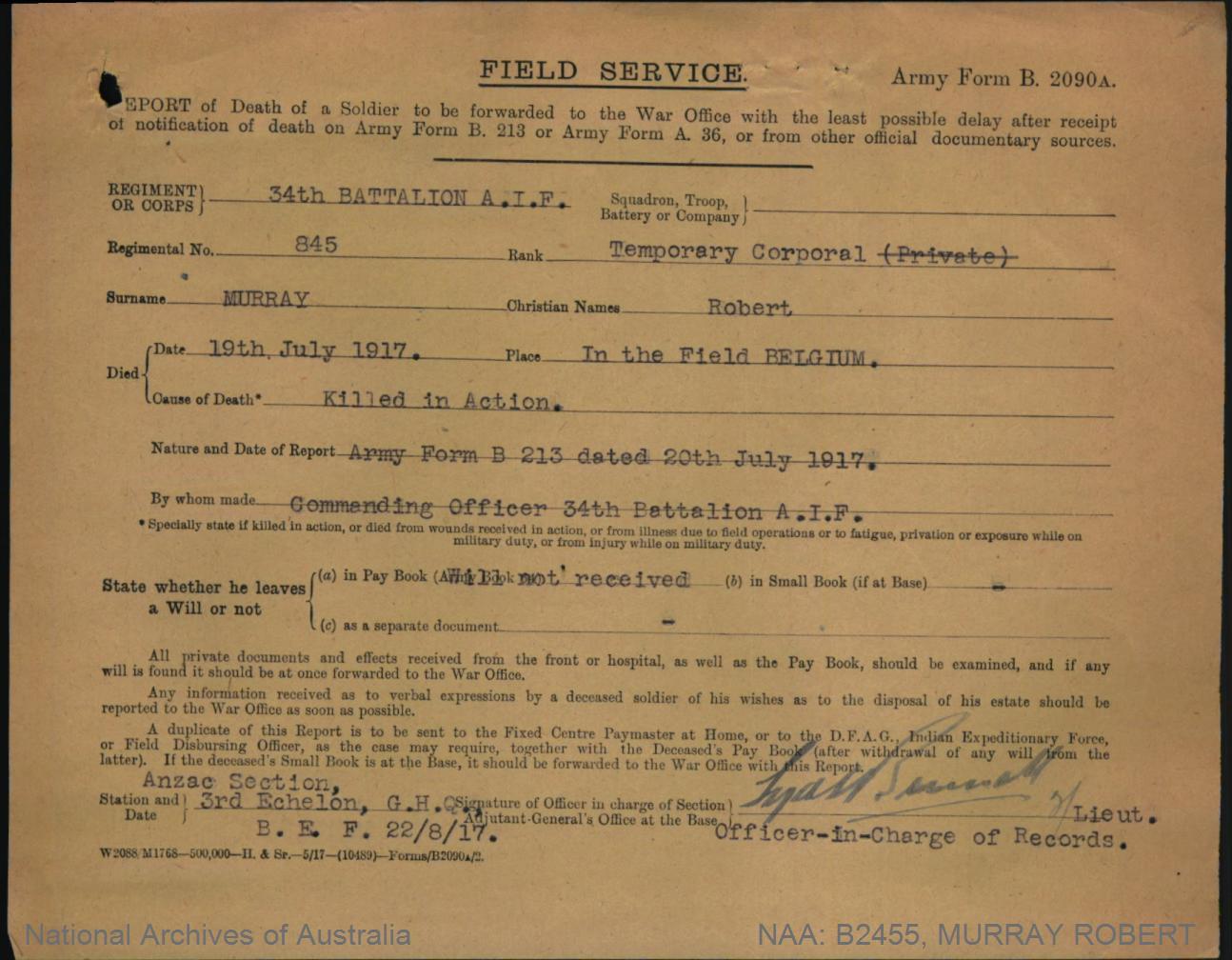
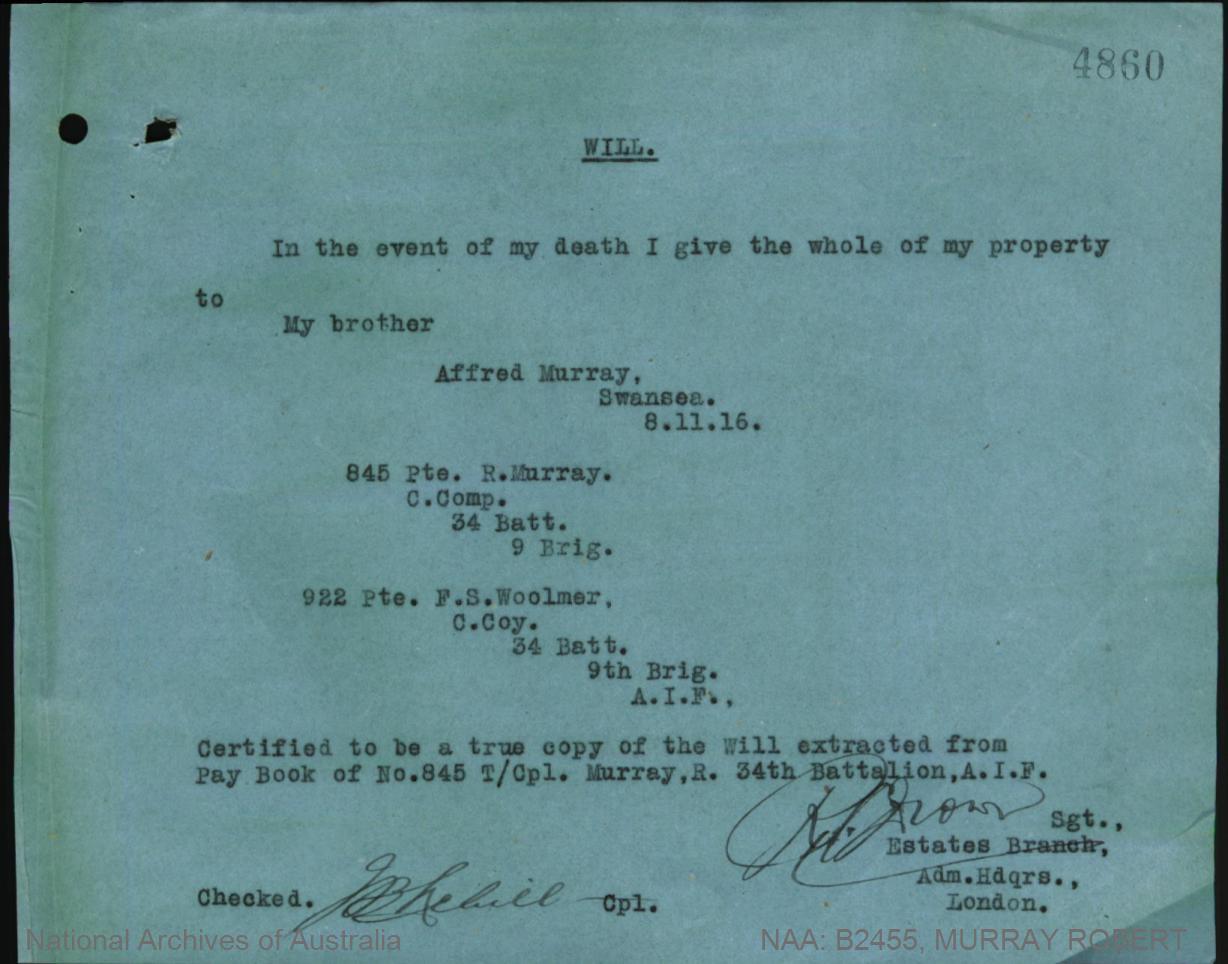
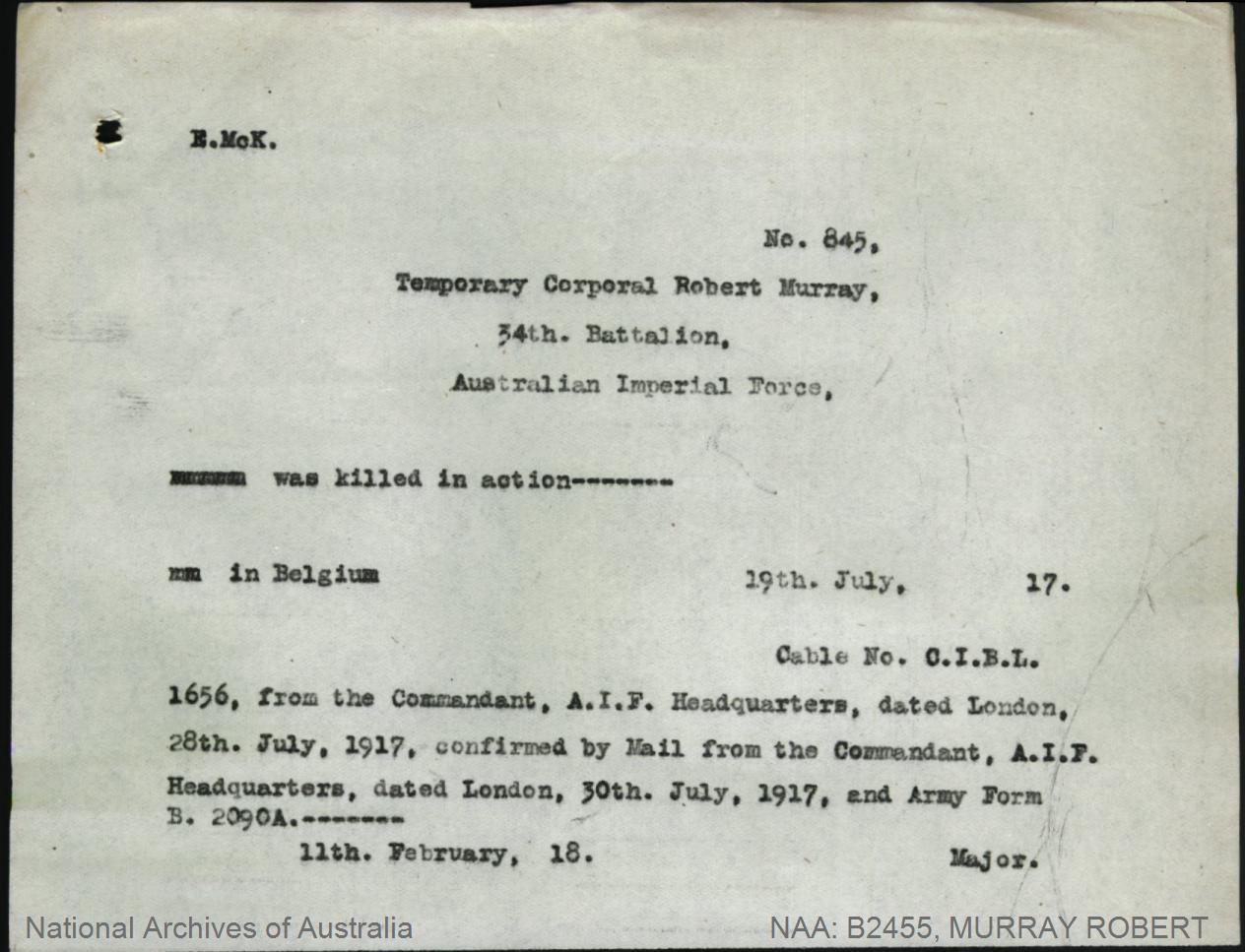
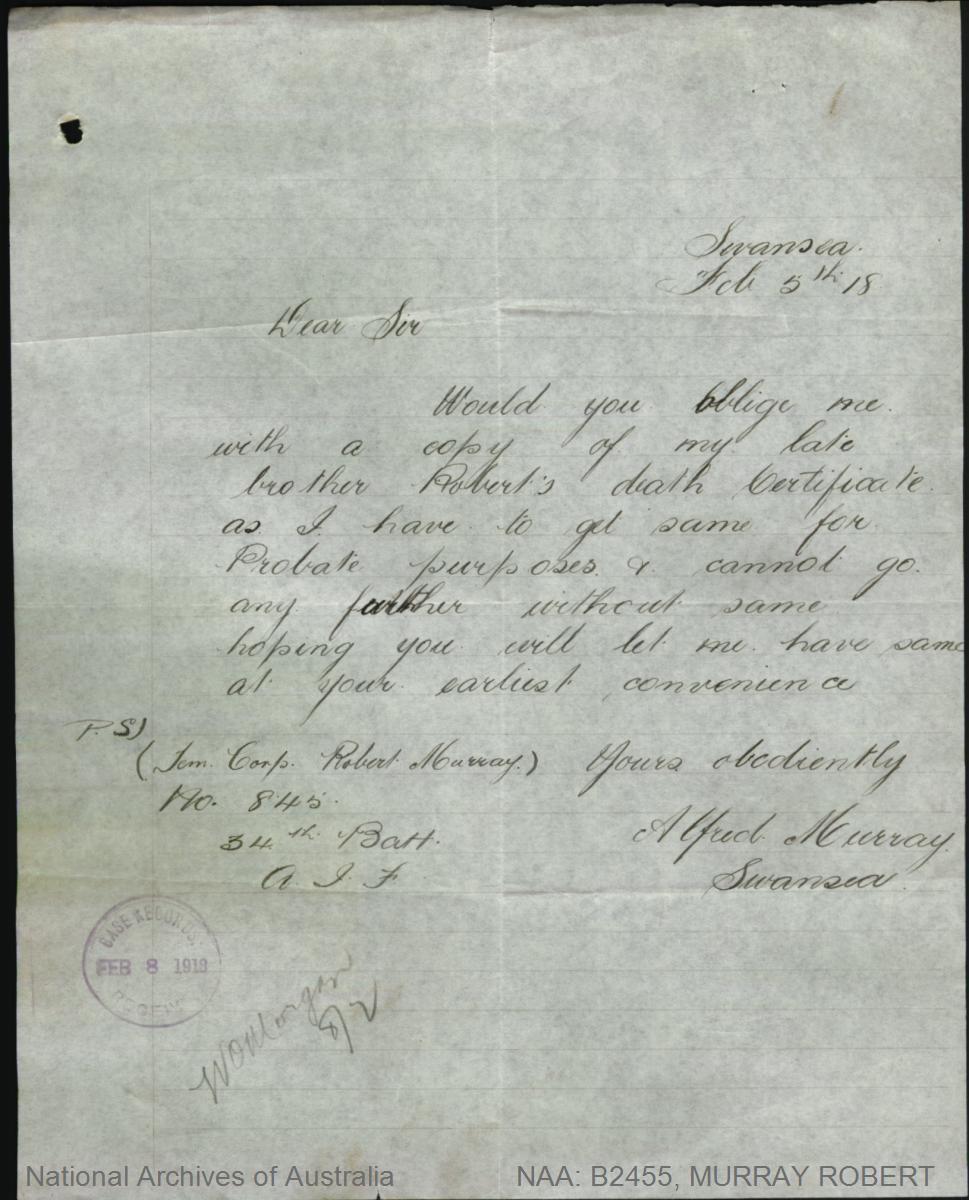

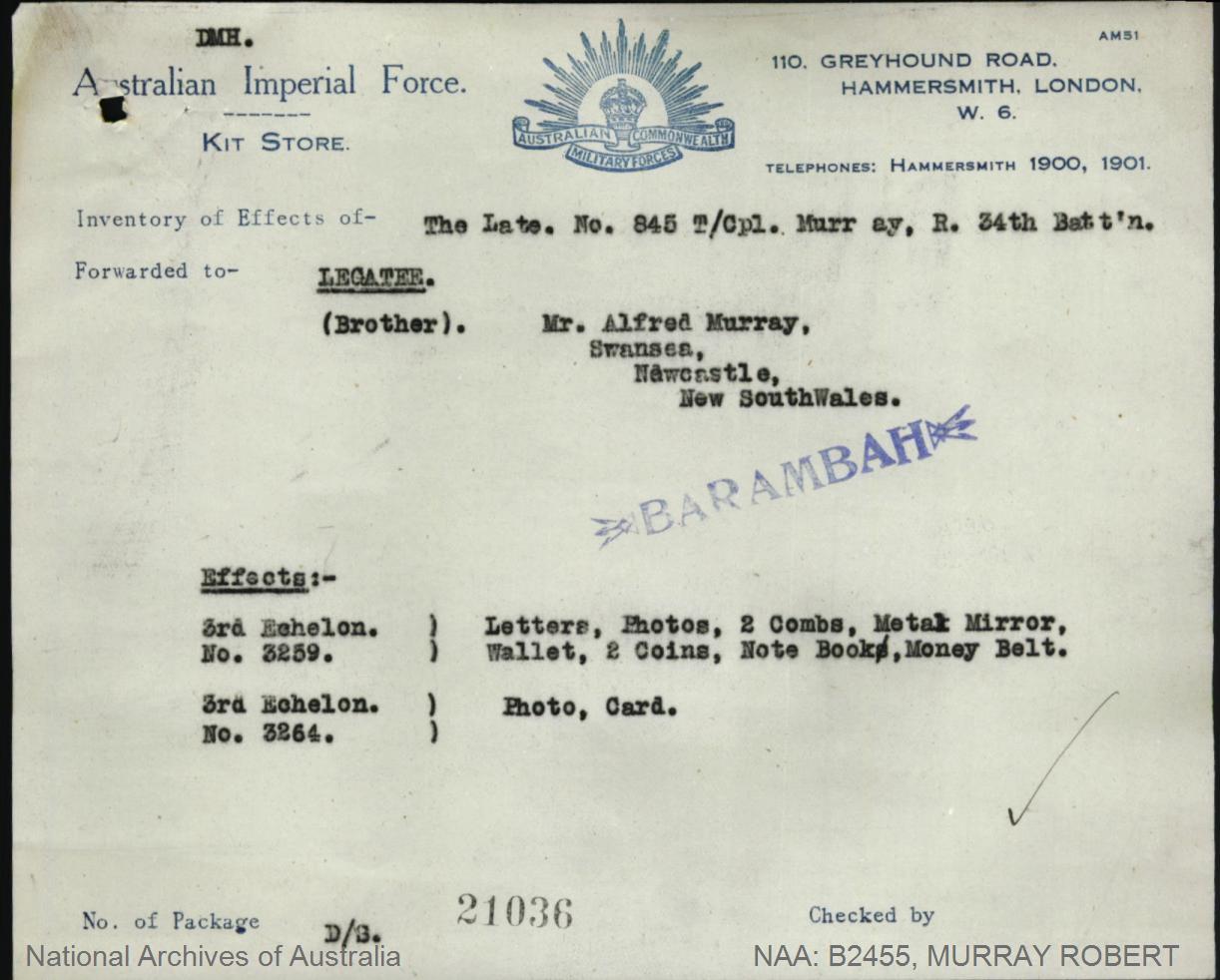


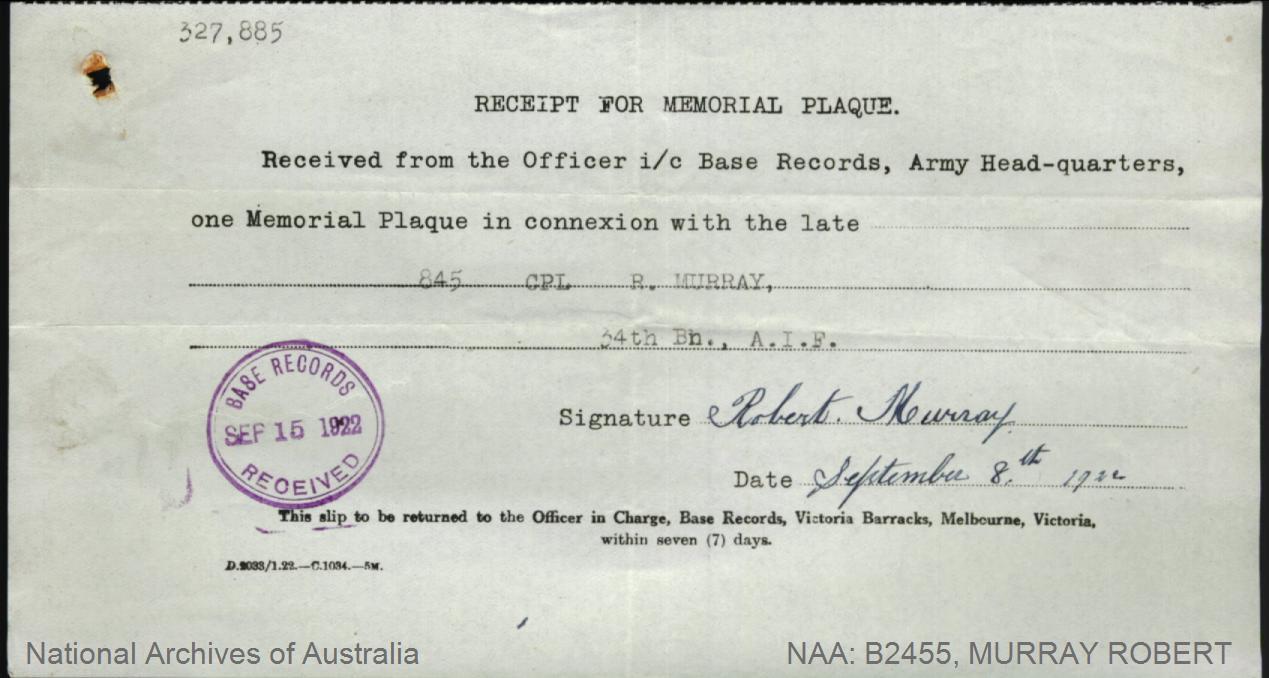
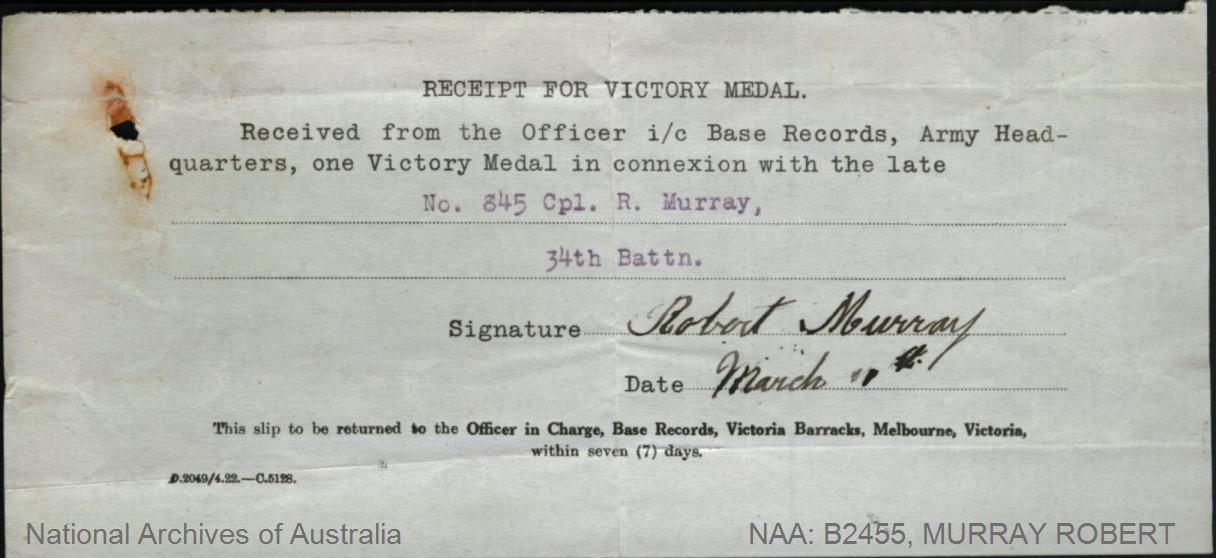


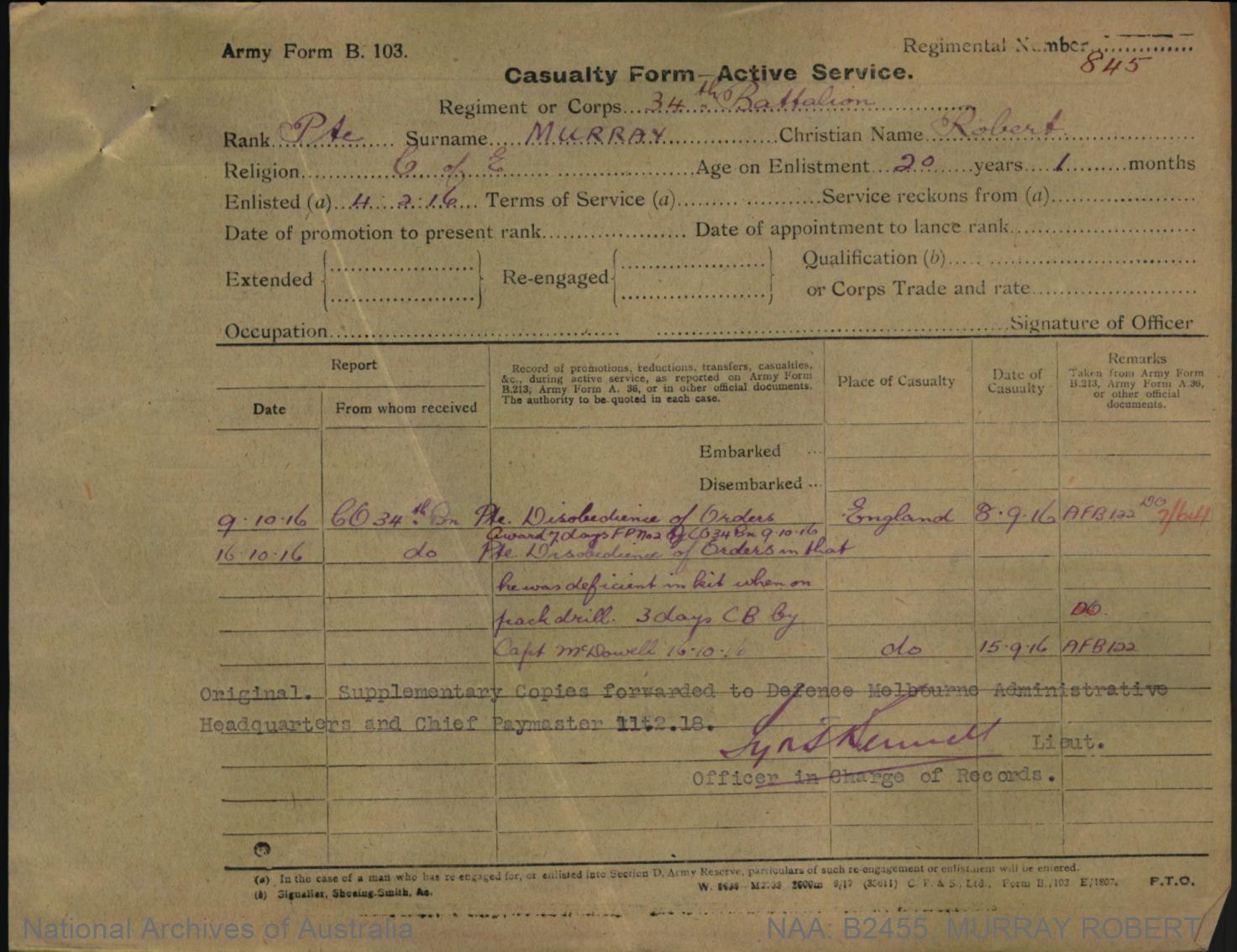
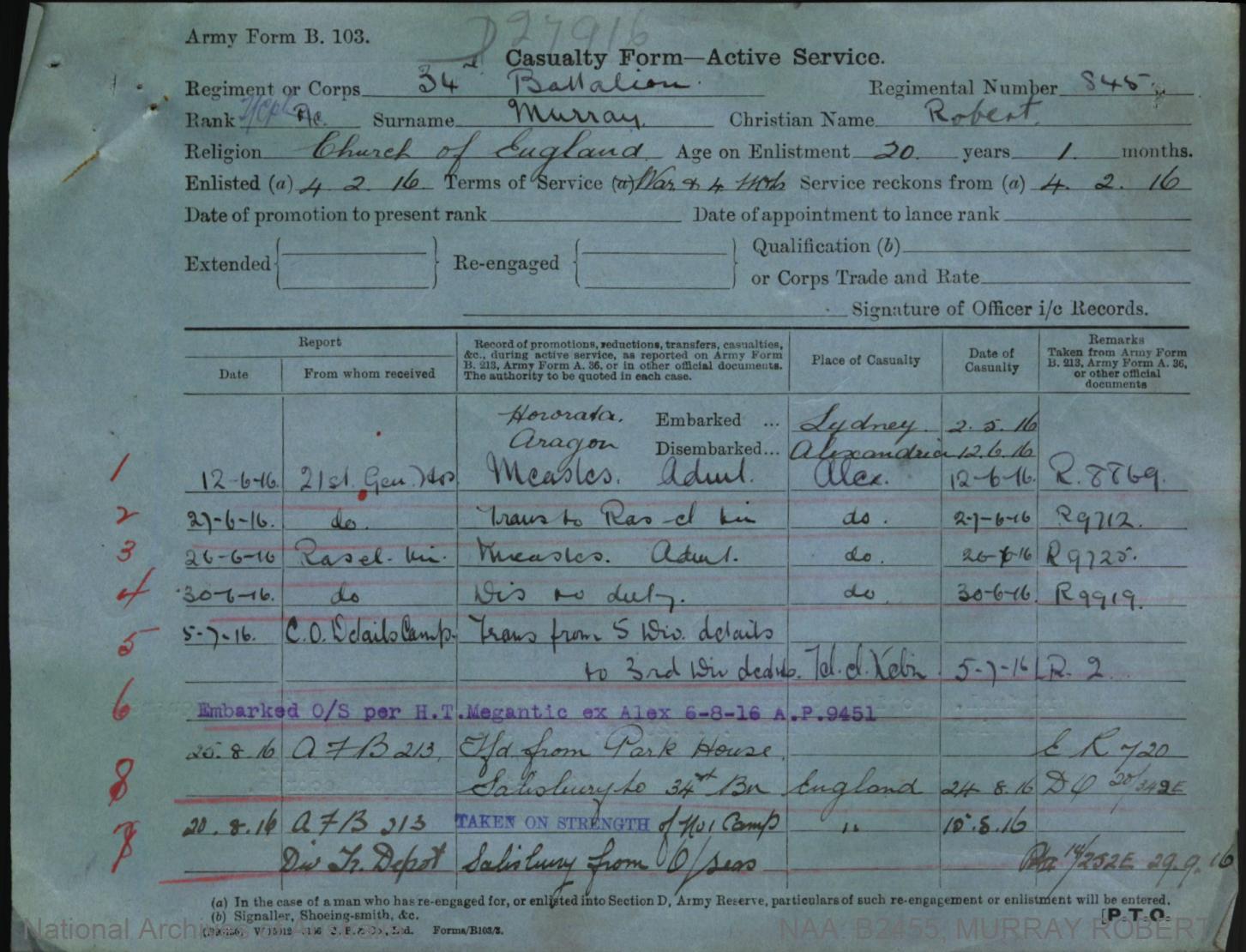
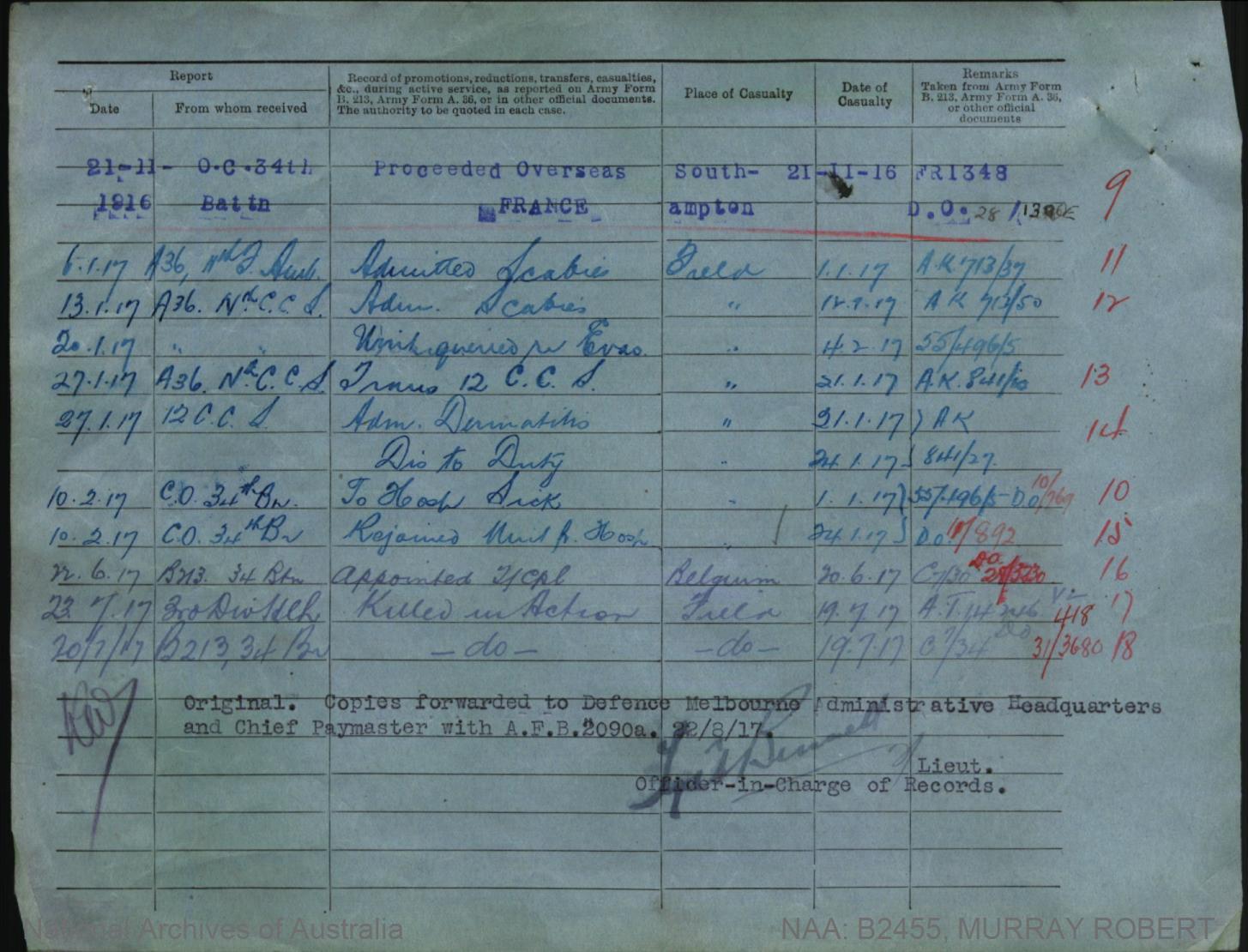



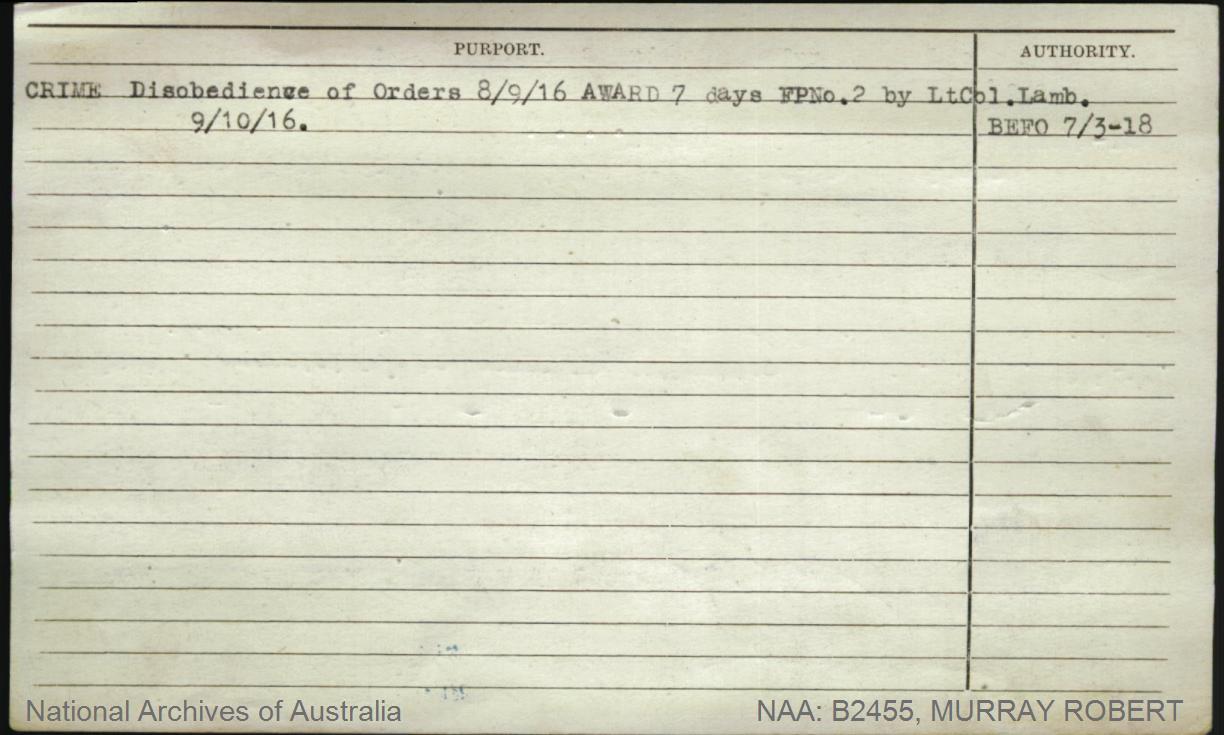

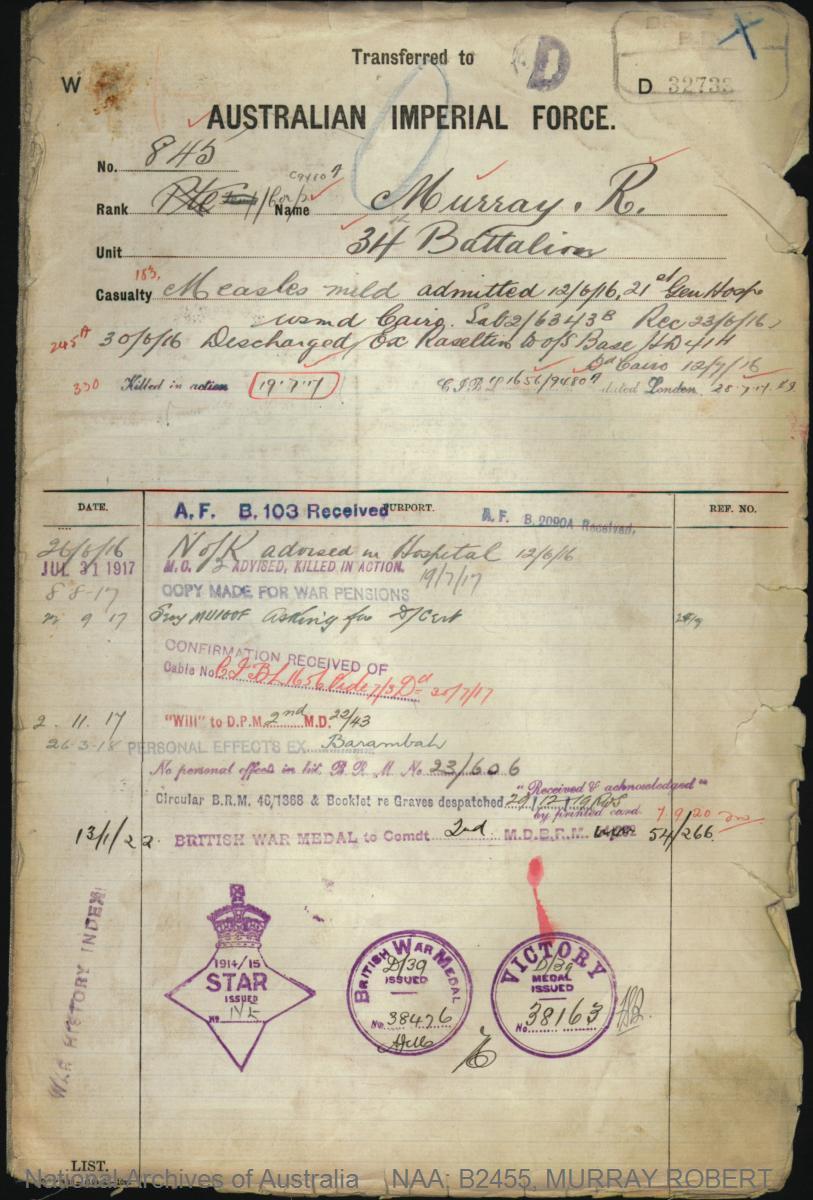

© Commonwealth of Australia (National Archives of Australia)
Under Construction: 30/06/2022-18/09/2022.